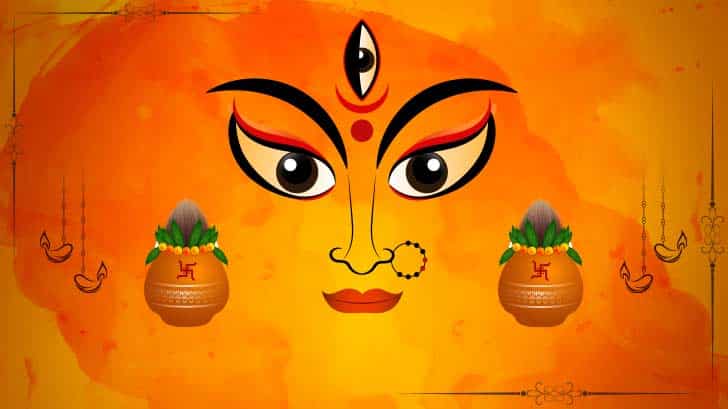
Informative
Importance of Gupt Navratri: A Hidden Path to Divine Power
The festival of Navratri holds profound significance in Hindu spirituality, celebrated with great devotion and reverence. While most people are familiar with the two prominent Navratris—Chaitra Shukla Navratri and Sharadiya Navratri—there exist two lesser-known, secret Navratris. These are referred to as Gupt Navratris, celebrated in deep secrecy by Brahmins, Sadhaks (spiritual practitioners), and Tantriks.
These sacred periods are a time for them to invoke and harness divine powers under the guidance of a Guru and with the blessings of the Mother Goddess. During these Navratris, practitioners engage in intense worship and Sadhanas (spiritual practices) away from the distractions of the material world, focusing entirely on spiritual upliftment.
What Are Gupt Navratris?
Gupt Navratri begins on the Shukla Pratipada (the first day of the waxing moon) in the months of Magh and Ashadh. These periods are considered highly auspicious and spiritually potent for those on the path of Tantra Sadhana.
It is believed that during these times, when Lord Vishnu enters his Yoga Nidra (cosmic slumber), negative and evil energies in the world increase. To counter these forces and maintain cosmic balance, devotees worship different forms of the Mother Goddess. These Sadhanas are rigorous and require a deep commitment to the spiritual path.
Devotees invoke the Mother Goddess during Gupt Navratri for protection, purity, and blessings. Chanting specific Tantra Mantras amplifies the spiritual energy and brings divine grace. Here are some powerful mantras you can use during this time:
Om Aim Hreem Kleem Chamundayei Vicche.
Om Paa Parvati Devyai Namah.
Ya Devi Sarva Bhuteshu Lakshmi Rupen Sansthita.
Namastasyai Namastasyai Namastasyai.
These mantras, charged with divine vibrations, act as conduits to connect with the Goddess’s energy and blessings.
The Worship of the Ten Mahavidyas
During Gupt Navratri, practitioners focus on the worship of the Das Mahavidyas (the ten great wisdom goddesses) as part of Tantra Sadhana. These fierce and powerful forms of the Goddess represent different aspects of cosmic energy and are worshipped to gain spiritual powers and overcome obstacles. Let us explore these Mahavidyas:
Maa Kali: The primordial, tantric form of the Goddess, representing time and transformation. Worshiping Maa Kali dissolves ego and destroys negativity.
Maa Tara: The liberator and granter of success. She is the embodiment of guidance and protection.
Maa Chhinnamasta: Known as the self-sacrificing Goddess, she removes all troubles and worries. Her name means “she who is severed-headed,” symbolizing the cutting away of ignorance and ego.
Maa Shodashi (Lalita Tripurasundari): The epitome of beauty and perfection, she is the Chandi form of the Goddess, granting ultimate liberation and bliss.
Importance of Gupt Navratri: A Hidden Path to Divine Power
The festival of Navratri holds profound significance in Hindu spirituality, celebrated with great devotion and reverence. While most people are familiar with the two prominent Navratris—Chaitra Shukla Navratri and Sharadiya Navratri—there exist two lesser-known, secret Navratris. These are referred to as Gupt Navratris, celebrated in deep secrecy by Brahmins, Sadhaks (spiritual practitioners), and Tantriks.
These sacred periods are a time for them to invoke and harness divine powers under the guidance of a Guru and with the blessings of the Mother Goddess. During these Navratris, practitioners engage in intense worship and Sadhanas (spiritual practices) away from the distractions of the material world, focusing entirely on spiritual upliftment.
What Are Gupt Navratris?
Gupt Navratri begins on the Shukla Pratipada (the first day of the waxing moon) in the months of Magh and Ashadh. These periods are considered highly auspicious and spiritually potent for those on the path of Tantra Sadhana.
It is believed that during these times, when Lord Vishnu enters his Yoga Nidra (cosmic slumber), negative and evil energies in the world increase. To counter these forces and maintain cosmic balance, devotees worship different forms of the Mother Goddess. These Sadhanas are rigorous and require a deep commitment to the spiritual path.
Devotees invoke the Mother Goddess during Gupt Navratri for protection, purity, and blessings. Chanting specific Tantra Mantras amplifies the spiritual energy and brings divine grace. Here are some powerful mantras you can use during this time:
Om Aim Hreem Kleem Chamundayei Vicche.
Om Paa Parvati Devyai Namah.
Ya Devi Sarva Bhuteshu Lakshmi Rupen Sansthita.
Namastasyai Namastasyai Namastasyai.
These mantras, charged with divine vibrations, act as conduits to connect with the Goddess’s energy and blessings.
The Worship of the Ten Mahavidyas
During Gupt Navratri, practitioners focus on the worship of the Das Mahavidyas (the ten great wisdom goddesses) as part of Tantra Sadhana. These fierce and powerful forms of the Goddess represent different aspects of cosmic energy and are worshipped to gain spiritual powers and overcome obstacles. Let us explore these Mahavidyas:
Maa Kali: The primordial, tantric form of the Goddess, representing time and transformation. Worshiping Maa Kali dissolves ego and destroys negativity.
Maa Tara: The liberator and granter of success. She is the embodiment of guidance and protection.
Maa Chhinnamasta: Known as the self-sacrificing Goddess, she removes all troubles and worries. Her name means “she who is severed-headed,” symbolizing the cutting away of ignorance and ego.
Maa Shodashi (Lalita Tripurasundari): The epitome of beauty and perfection, she is the Chandi form of the Goddess, granting ultimate liberation and bliss.
Maa Bhuvaneshwari: The Queen of the Universe, she bestows wealth, power, and status. She is ideal for those seeking prominence in life.
Maa Tripura Bhairavi: She represents Tamoguna (inertia) and Rajoguna (activity) and is worshipped for balance and spiritual discipline.
Maa Dhumavati: The fierce widow Goddess who protects from troubles and obstacles. Her worship is often undertaken by those seeking liberation from grief and suffering.
Maa Baglamukhi: The Goddess of Stambhan Shakti (paralyzing power). She silences enemies and destroys obstacles, ensuring victory in all endeavors.
Maa Matangi: The Goddess of music, art, and speech. She grants the boon of fearlessness and excellence in creative fields.
Maa Kamala: The tantric form of Goddess Lakshmi, she grants all material comforts and worldly success.
The Significance of Worship
The ten Mahavidyas are worshipped in a highly disciplined manner during Gupt Navratri. These practices are not merely rituals but acts of Bhakti (devotion) and Shakti Aradhana (worship of divine energy). Each of these goddesses symbolizes a unique aspect of cosmic energy, and their blessings empower the practitioner to overcome both material and spiritual challenges.
Why Gupt Navratri Is Special?
The hidden nature of Gupt Navratri symbolizes the inner journey of the soul. Unlike the external celebrations of Sharadiya and Chaitra Navratri, Gupt Navratri focuses on the Antar Yatra (inner pilgrimage). It is a time to retreat from the world, embrace silence, and align oneself with the vibrations of the divine feminine energy.
By worshipping the ten Mahavidyas during Gupt Navratri, practitioners aim to:
Gain mastery over their senses and mind.
Dissolve karmic blockages and remove negativity.
Attain spiritual enlightenment and material prosperity.
The fierce yet compassionate energy of the Mahavidyas guides the practitioner to walk the path of Moksha (liberation) while fulfilling worldly duties. Gupt Navratri, therefore, becomes a sacred opportunity to balance the spiritual and material realms.
Gupt Navratri is not just a festival; it is a profound spiritual practice rooted in the timeless wisdom of Hindu Tantra. By dedicating these sacred days to intense Sadhana and worship, one can unlock the infinite potential of divine blessings and transform life on every level—physical, mental, and spiritual. The Queen of the Universe, she bestows wealth, power, and status. She is ideal for those seeking prominence in life.
Maa Tripura Bhairavi: She represents Tamoguna (inertia) and Rajoguna (activity) and is worshipped for balance and spiritual discipline.
Maa Dhumavati: The fierce widow Goddess who protects from troubles and obstacles. Her worship is often undertaken by those seeking liberation from grief and suffering.
Maa Baglamukhi: The Goddess of Stambhan Shakti (paralyzing power). She silences enemies and destroys obstacles, ensuring victory in all endeavors.
Maa Matangi: The Goddess of music, art, and speech. She grants the boon of fearlessness and excellence in creative fields.
Maa Kamala: The tantric form of Goddess Lakshmi, she grants all material comforts and worldly success.
The Significance of Worship
The ten Mahavidyas are worshipped in a highly disciplined manner during Gupt Navratri. These practices are not merely rituals but acts of Bhakti (devotion) and Shakti Aradhana (worship of divine energy). Each of these goddesses symbolizes a unique aspect of cosmic energy, and their blessings empower the practitioner to overcome both material and spiritual challenges.
Why Gupt Navratri Is Special?
The hidden nature of Gupt Navratri symbolizes the inner journey of the soul. Unlike the external celebrations of Sharadiya and Chaitra Navratri, Gupt Navratri focuses on the Antar Yatra (inner pilgrimage). It is a time to retreat from the world, embrace silence, and align oneself with the vibrations of the divine feminine energy.
By worshipping the ten Mahavidyas during Gupt Navratri, practitioners aim to:
Gain mastery over their senses and mind.
Dissolve karmic blockages and remove negativity.
Attain spiritual enlightenment and material prosperity.
The fierce yet compassionate energy of the Mahavidyas guides the practitioner to walk the path of Moksha (liberation) while fulfilling worldly duties. Gupt Navratri, therefore, becomes a sacred opportunity to balance the spiritual and material realms.
Gupt Navratri is not just a festival; it is a profound spiritual practice rooted in the timeless wisdom of Hindu Tantra. By dedicating these sacred days to intense Sadhana and worship, one can unlock the infinite potential of divine blessings and transform life on every level—physical, mental, and spiritual.
Post a Comment
-
Subscribe to Our Blog
-
Categories
-
Popular Articles
- Dead moth in the house. What universe is trying to tell you?
- Spiritual Meaning of Moth
- Vivah Bandhan Curse – What Is It and How to Spiritually Heal It.
- The Dasa Mahavidyas
- What are Beej Mantras?
- Tripura Sundari | The Dasa Mahavidya
- Maa Bhuvaneshwari | The Dasa Mahavidyas
- The Five Shades of Tantra
- Ramakrishna Paramhansa – The Man who almost became a Woman
- Maa Chinnamasta | The Dasa Mahavidyas



